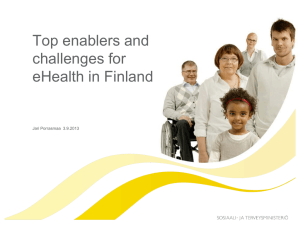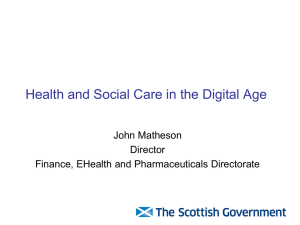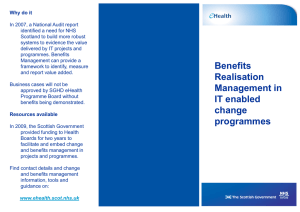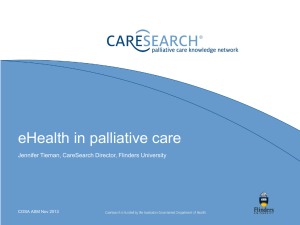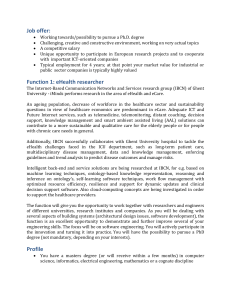Document 13179992
advertisement
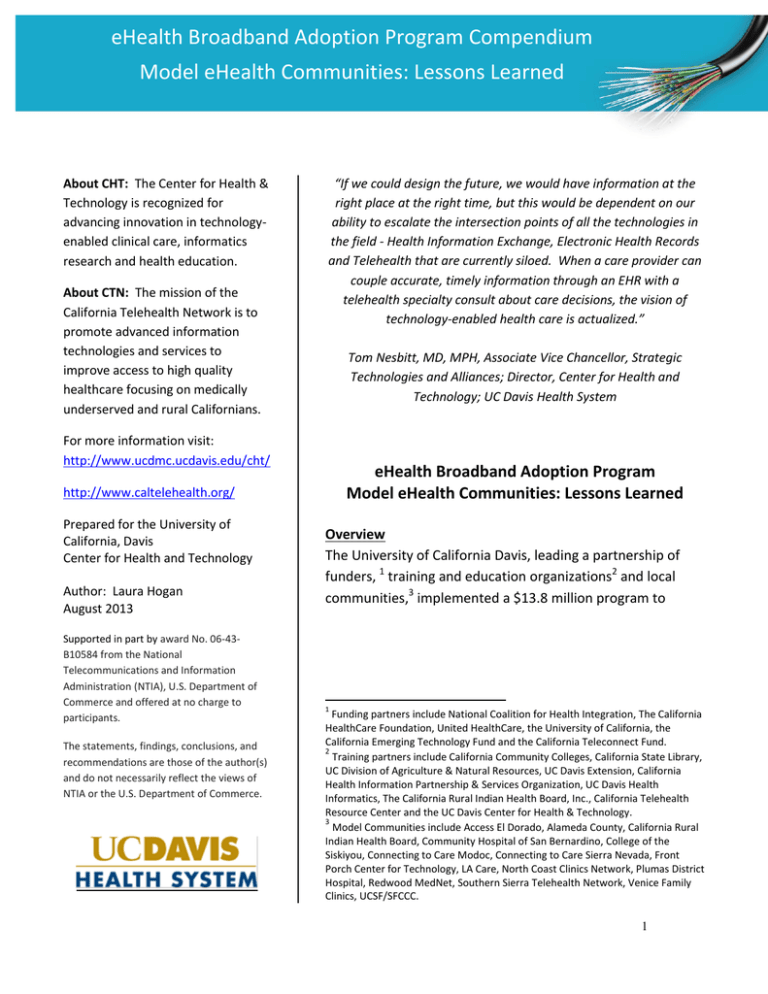
eHealth Broadband Adoption Program Compendium Model eHealth Communities: Lessons Learned About CHT: The Center for Health & Technology is recognized for advancing innovation in technologyenabled clinical care, informatics research and health education. About CTN: The mission of the California Telehealth Network is to promote advanced information technologies and services to improve access to high quality healthcare focusing on medically underserved and rural Californians. “If we could design the future, we would have information at the right place at the right time, but this would be dependent on our ability to escalate the intersection points of all the technologies in the field - Health Information Exchange, Electronic Health Records and Telehealth that are currently siloed. When a care provider can couple accurate, timely information through an EHR with a telehealth specialty consult about care decisions, the vision of technology-enabled health care is actualized.” Tom Nesbitt, MD, MPH, Associate Vice Chancellor, Strategic Technologies and Alliances; Director, Center for Health and Technology; UC Davis Health System For more information visit: http://www.ucdmc.ucdavis.edu/cht/ eHealth Broadband Adoption Program Model eHealth Communities: Lessons Learned http://www.caltelehealth.org/ Prepared for the University of California, Davis Center for Health and Technology Author: Laura Hogan August 2013 Supported in part by award No. 06-43B10584 from the National Telecommunications and Information Administration (NTIA), U.S. Department of Commerce and offered at no charge to participants. The statements, findings, conclusions, and recommendations are those of the author(s) and do not necessarily reflect the views of NTIA or the U.S. Department of Commerce. Overview The University of California Davis, leading a partnership of funders, 1 training and education organizations2 and local communities,3 implemented a $13.8 million program to 1 Funding partners include National Coalition for Health Integration, The California HealthCare Foundation, United HealthCare, the University of California, the California Emerging Technology Fund and the California Teleconnect Fund. 2 Training partners include California Community Colleges, California State Library, UC Division of Agriculture & Natural Resources, UC Davis Extension, California Health Information Partnership & Services Organization, UC Davis Health Informatics, The California Rural Indian Health Board, Inc., California Telehealth Resource Center and the UC Davis Center for Health & Technology. 3 Model Communities include Access El Dorado, Alameda County, California Rural Indian Health Board, Community Hospital of San Bernardino, College of the Siskiyou, Connecting to Care Modoc, Connecting to Care Sierra Nevada, Front Porch Center for Technology, LA Care, North Coast Clinics Network, Plumas District Hospital, Redwood MedNet, Southern Sierra Telehealth Network, Venice Family Clinics, UCSF/SFCCC. 1 increase adoption of broadband-enabled eHealth technology and sustain California’s Federal Communications Commission-funded broadband network. Recovery Act funding of $9.1 million from the Department of Commerce, Broadband Technology Opportunities Program was matched with $4.7 million of local funding to support California’s far-reaching eHealth Broadband Adoption Initiative (Initiative). Underpinning program design was the understanding that success would require not just broadband and equipment, but also training, leadership to manage organizational changes, and sustained education strategies for consumers and health care professionals. To ensure success, the Initiative supported the following strategies: • • • Low cost access to a statewide managed, medical grade broadband network through the California Telehealth Network; Online and community-based training programs focused on broadband dependent technologies for organizations, consumers, information technology and health care professionals; and, Model eHealth Community Project support for equipment and implementation of eHealth applications. This report is part of a project compendium that includes a series of papers and four video presentations of Model eHealth Community Projects.4 Together, the reports compile accomplishments, challenges and lessons-learned from a review of data, grant reports, focus group discussion and interviews with state and local community partners. The Initiative did not include a formal evaluation or research, however the compendium presents a wealth of qualitative findings. This paper presents information from Model eHealth Community grants that supported collaborative partnerships and start up or expansion of eHealth projects across the state. Companion papers include an Initiative Overview, an inventory description of Model eHealth Communities, and an essay on the Initiative’s contributions to improved health care. Model eHealth Communities Model eHealth Community funding was intended to support the full utilization of telehealth equipment and CTN connectivity to accomplish a broad array of services including specialty consultations, distance education, on-line education, patient education, on-line support groups and other services. Fifteen Model eHealth Communities were funded based on readiness, need, and capacity for success and will sustain a lasting capacity of eHealth applications and services. Dispersed throughout California, the Model eHealth Communities included 70 organizations and 100 sites in 26 counties (see map in appendix). Funded projects include: urban eHealth projects with a goal to improve access to specialty 4 eHealth Broadband Adoption Program Initiative Overview, Model eHealth Communities Lessons Learned, Model eHealth Communities Inventory, eHealth Broadband Adoption Initiative and Improved Care. Videos of Alameda Juvenile Justice, Front Porch, Connecting to Care and ACCEL are available at : www.ucdmc.ucdavis.edu/cht/initiatives/eHealthTraining.html eHealth Broadband Adoption Program Model eHealth Communities: Lessons Learned 2 care; rural eHealth projects working to attain reliable broadband and increase access to care for residents of remote areas; and, special population projects to address unique needs among underserved populations. Model communities and their partners implemented more than 25 clinical services using new connectivity and equipment that will continue to foster timely access to care (see graphs in the appendix). Telehealth visits totaled almost 40,000 over the two year period. In addition, digital exchange of health information and e-prescribing totaled almost 100,000 encounters. Successes, Challenges and Lessons Learned from Model eHealth Communities Long Term Outcome eHealth Broadband Adoption Initiative Low cost, reliable broadband access, eHealth equipment distribution, technologydependent training, consumer education and broad community partnerships will demonstrate improvements that support sustained adoption. Model eHealth Community projects demonstrate the innovation and potential for eHealth applications and offer new insights about what local implementation requires. The themes and lessons-learned compiled here emanate from the wisdom and commitment of local leaders working to advance the field. Access to care, coordination of care and satisfaction with care improves immediately: Model Communities and their partners implemented more than 25 clinical services using new connectivity and equipment. Telehealth programs demonstrated immediate success in improving timely access and coordination of care and achieving satisfaction from patients. Consumers consistently offer high marks for the experience of individual visits as well as overall care improvements. Patients speak to the ability to access specialty care more rapidly, receive local care from distant tertiary care medical center specialists and reduce their expense and travel time for visits. Regardless of urban, rural or special population focus, all Model Communities successfully improved access to care. . . . Healthcare District held their community planning meeting in June and approximately 70 community members attended. The community asked for additional telehealth specialty services to be added at the clinic. They expressed a high level of satisfaction with the current telehealth services and appreciate not having to travel out of region to receive them. They also mentioned that without telehealth, they are not able to access many services, particularly in winter months when travel over local/regional mountain passes is hazardous. Rural Northern CA Model eHealth Community We have seen access to specialty care improve, and partners report that patient satisfaction with care improves dramatically when their primary care physician coordinates directly with the specialist (especially with patient in the room). The increased communication between specialist and caregiver has also improved the willingness to utilize telehealth, as primary care physicians gain immediate feedback and learning that is valuable to them. Rural Southern CA Model eHealth Community eHealth Broadband Adoption Program Model eHealth Communities: Lessons Learned 3 In Behavioral Health settings, the consumer actually prefers the distance from the specialist, is more willing to disclose potentially embarrassing information. Southern CA Model eHealth Community Quality of care improves through formal and informal mechanisms: An underappreciated feature of telehealth visits is the quality improvement that results when primary care providers, patients and specialty providers participate together in the visit. There is real-time coordination of next steps, questions are asked and answered efficiently, and primary care providers learn about management of the condition. In addition to these informal methods, Model Communities implemented formal systems of eHealth quality improvement for providers. For example, two communities are implementing strategies based on Project ECHO, a model developed by the University of New Mexico in which academic medical centers share specialized knowledge with local clinicians to treat chronic conditions. A web-based eConsult Safety Net Program implemented in Los Angeles allows 1,300 primary care physicians in 108 clinics to access specialty consults from 14 specialty care areas. Technology also facilitated formal participation in tumor boards, Grand Rounds and continuing education that contribute to quality of care improvements. Patients might wait 15 months for a dermatology consult. When we implemented eConsult, we got a result in 4-5 days and 60% could be treated in the primary care practice without seeing a specialist. Urban Southern CA Model eHealth Community Medical providers attending tumor conferences via tele-videoconferencing love having the opportunity to participate and learn. Rural Northern CA Model eHealth Community Consumer health and health literacy improvement is fledgling but on the rise: Ambitious plans to connect nontraditional partners and implement new community-based eHealth applications did not all materialize as Model Communities scaled back non-clinical applications in the face of delays and implementation challenges. Therefore, it is all the more notable that a number of innovative consumer eHealth applications were implemented. Project staff noted the unlimited potential of consumer applications to contribute to behavior change and health improvement through better understanding and engagement in health care and voiced concern that the health care system has not yet provided any consistent funding mechanisms to sustain support for consumer engagement. Some consumer eHealth strategies implemented in Model Communities include: health education video workshops on healthy aging and training for non-English speaking seniors on how to access health information in their language; remote patient monitoring of vital signs; breast cancer support groups connecting participants and leaders over multiple geographies; interpreter services via video conference; and, eligibility determination by video conference (tele-eligibility) for public benefits. eHealth Broadband Adoption Program Model eHealth Communities: Lessons Learned 4 Consumers were able to take direct control over their own health by enrolling in computer and health literacy trainings that taught them in-language; they were better informed about their own health and the meaning of health vital signs by administering their own testing with blood pressure cuffs, weight scales, oximeters, and glucometers. Urban Southern CA Model eHealth Community . . . health information kiosk utilization has improved patient recall of recommendations. Providers are dealing with better informed consumers, who have printed out health information to bring in to their visit and they feel more confident that care instructions were retained. Rural Southern CA Model eHealth Community . . . we were able to work with family resource centers to create a support network for staff and clients. This allowed staff to assist remotely around language or social service navigation. Rural Northern CA Model eHealth Community For the interpreter, video allows them to access important visual body language cues that enhance their ability to facilitate the most effective, sensitive, high quality and safe communication between patient and provider. Reducing wait times to access interpreter services and removing costs associated with travel and wait time for interpreters will allow hospitals and clinics to become more efficient in serving both providers and patients. Urban Northern CA Model eHealth Community Competing priorities, especially multiple technology efforts such as EHR, was a common challenge that slowed progress: Simultaneous technology implementations competed for limited IT capacity in many sites and made solving problems such as network configuration and firewall issues a difficult bottle neck. Many hospitals and clinics are in the midst of implementing EHR, which consumes significant time and resources and communities report that EHR efforts typically were viewed as a higher priority than new telehealth activities. This slowed overall implementation, leaving some projects with work yet to be accomplished as grants end. The rate at which an agency can work towards the implementation of telehealth is affected by other obligations that key staff may have, such as EMR implementation. Interview, Statewide Initiative Partner Technical and infrastructure solutions are unique to each implementation; external technical assistance is needed for many organizations: Implementation requires navigating technology and facility issues for each location. Firewalls, network configuration, space limitations and assessment of what telehealth equipment is needed require time commitment and creative problem solving by staff in the host site. Many health care entities are small and lack dedicated IT staff with the expertise to accurately assess equipment needs and solve technical barriers. As the initiative progressed, technical assistance was strengthened and gained traction to great advantage. Despite engaging in thoughtful planning processes, the realities of implementing telehealth technology equipment only fully revealed themselves once implementation began. When the equipment was up and running, partner agencies found that expected functionalities did not work as expected, required eHealth Broadband Adoption Program Model eHealth Communities: Lessons Learned 5 additional configuration with existing systems, and was further compounded by the varying degree of IT resources and understanding at the clinical site level. Urban Southern CA Model eHealth Community Our equipment required some new connections for the high resolution quality that we didn’t realize at the outset. We needed to revamp things quickly and that took IT prioritizing our issue. Focus Group Participant Clinician champions can overcome initial reluctance to participate: Clinical champion efforts to encourage clinician participation relies on the right messenger who is able to help providers overcome discomfort with technology, understand and address work flow changes and convey the details of how to conduct a clinical visit when one provider must rely on another for the hands-on aspect of the visit. Once the telehealth highway exists and local primary care clinicians are recruited, there are additional challenges that rely on a clinician champion, such as how to prioritize which specialty needs are most critical and how to find willing specialists with telehealth capacity. The key lesson learned is the need for provider leadership. Without it, the telehealth system is just a bunch of wires and monitors. Urban Northern CA Model eHealth Community . . . adoption by medical staff remains challenging and is tough to address. Telehealth is a change to the current model of care that practitioners are accustomed to. With all of the changes that have taken place over the last two years, implementing and adopting another change in the model of care has taken involvement of clinician leaders. Urban Northern CA Model eHealth Community Administrative leadership facilitates focus and ensures resources: Every Model Community reports myriad coordination and start-up issues faced over the course of implementation. Telehealth services require attention to contracts, credentialing, facility, insurance, billing and bylaws, involving multiple administrative departments. Beyond the specific administrative changes, telehealth also brings new partnerships, organizational practices and work flow that demand organizational change. These efforts benefit from proactive leadership attention to champion the change. Where leadership champions were not present or where there was turn over in leadership levels, projects experienced significant delays and in a few cases were not able to successfully implement services within the grant period. Initially viewed as a 2-site project to solve after-hours 5150 evaluations in the Emergency Department, however, once leadership got involved, it became a system approach with policy, privacy, credentialing, and contracting at a global level rather than site level and we are going live in 10 hospitals. Focus Group Participant Credentialing, bylaws and contracting have been the largest challenges we have faced. Indeed it took involvement at the highest levels of management and corporate attention to make this happen. Rural Southern CA Model eHealth Community Facility issues can be overcome with advance planning: Space considerations are paramount to easy access to equipment and can mean the difference between using telehealth or having equipment gather eHealth Broadband Adoption Program Model eHealth Communities: Lessons Learned 6 dust. Planning ahead by someone who has experience with telehealth visits can save frustration and expense later when equipment and technology installations must be relocated because the room is too small to accommodate the equipment or the telecart is in a room not easily accessible to all the different specialists. We struggled throughout the grant with space issues, especially to find a permanent space for the telehealth video carts so they could be used for on-call mental health services. We face barriers to using the video carts when they are needed because they share space with others and are periodically inaccessible. Urban Southern CA Model eHealth Community Telehealth implementation requires resources AND generates revenue and leverage opportunities: Model Communities readily acknowledge the need for initial and ongoing organizational investments to start and sustain eHealth services however, they also point out revenue considerations to round out the business case for eHealth. Examples cited include billable patient revenue from increased local visits and services, patients retained in the local health system, leveraging outside grant funding and efficient use of existing resources. Telehealth visits for incarcerated individuals removed the need for correctional officers to leave the facility for extended visits to specialty providers and shortened the stay of some juvenile offenders, saving public resources and improving care. And, particularly in rural communities, where referral to a specialist or a higher acuity hospital means the patient often leaves the community for care, the availability of telehealth means visits, inpatient days, and ancillary revenues for laboratory and imaging, as well as pharmacy and other services that remain in the local economy. . . . Clinic was able to leverage its Model eHealth Community status to become a subcontractor on a large grant for dental services. We are partnering with the University of the Pacific’s Dental School to implement their Virtual Dental Home model. This pilot project has received permission from the state legislature to allow a dental hygienist to expand her duties and place sealants and interim therapeutic restorations (fillings) in the field. Our hygienist goes into early head start programs to deliver care and communicates notes and pictures about each patient to the Clinic’s pediatric dentist. Should the child’s dental problems prove to be extensive, the patient is referred for an in-person consult. This grant recently completed a very successful first year. Urban Southern CA Model eHealth Community Training and education can overcome initial barriers: Training resources were available to Model Communities from state level partners, however the need for training and technical assistance was not always recognized by local communities and some resources were developed too late in the grant to be of service. Some projects designed local workshops to meet their needs. In addition, the Center for Health and Technology and the California Telehealth Resource Center added hands-on assistance and training during the project, including a well attended Telehealth Summit to address observed needs. Moreover, toolkits and other materials are being developed in response to the experience gained from the grant. You don’t have to recreate the wheel – policies, procedures, templates and other material already exist so don’t waste time and effort recreating it. Rural Northern CA Model eHealth Community eHealth Broadband Adoption Program Model eHealth Communities: Lessons Learned 7 Prior to the grant, telehealth was largely “unknown” to our community with few agencies taking the steps to integrate this mode of care into their organization. Without adequate understanding of how telehealth could support or improve an organization’s ability to improve care, most agencies did not have the desire or will to utilize it. Through the training provided through online curriculum, in-person training, CTN resources and on-site training, we were able to improve clarity and build excitement about how it can help an organization deliver care. In addition to general knowledge, our community needed to know how to design and operationalize telehealth at their sites. Our agencies had a significant need to be trained on how to use the telehealth equipment, to explore the variety of applications for its use, and how to thoughtfully implement clinical services. Rural Northern CA Model eHealth Community The promise of payment reform and increased reimbursement through the Affordable Care Act lag behind the need: California is among the leaders in reimbursement for telehealth services through its Medi-Cal program yet providers report that payment is the most significant barrier they face in continuing and expanding services. Many sites use grant resources or rely on organizational support for funding. Two business strategies are commonly used in Model Communities for Medi-Cal reimbursement: 1) some sites pay specialty consulting providers for a block of time and operate under the risk that they can fill the visit schedule with enough billed patient services to break-even; 2) other sites operate with each provider billing directly for the visit. Even with a billing mechanism in place through Medi-Cal, in many localities, there is still a challenge of finding providers who accept Medi-Cal. Uninsured patients pose even more of a challenge. Communities cite future reforms under the Affordable Care Act as a solution and emphasize the need for payment reform in order to realize the potential of telehealth. Conclusion Model Communities and their 100 partner sites have significantly expanded eHealth services across California in recognition that eHealth is the future of health care. The numerous innovations and lessons learned through their efforts are a contribution to assist others as eHealth becomes standard practice. These communities recognize that consumers increasingly expect technology solutions to ease the challenges they experience in accessing care. Moreover, providers are embracing the benefits and efficiency of eHealth as they seek to improve quality and reduce cost. The eHealth Broadband Adoption Initiative and its community and funding partners achieved their goal to bring secure and reliable connectivity throughout California and expand access to eHealth applications. Moreover, the Initiative leaves a strong foundation of local champions and lessons learned to benefit continued expansion. eHealth Broadband Adoption Program Model eHealth Communities: Lessons Learned 8 Appendix Model eHealth Communities eHealth Broadband Adoption Program Model eHealth Communities: Lessons Learned 9 LA Care eConsults 3000 2500 2000 7/1/12 - 9/30/12 1500 10/1/12 - 12/31/12 1/1/13 - 3/31/13 1000 4/1/13 - 6/30/13 500 0 ENT Cardiology eHealth Broadband Adoption Program Model eHealth Communities: Lessons Learned Neurology Dermatology Optometry 10
